Vegetation Change and Its Response to Climate Change between 2000 and 2016 in Marshes of the Songnen Plain, Northeast China
Abstract
1. Introduction
2. Materials and Methods
2.1. Study Area
2.2. Data
2.3. Methods
3. Results
3.1. Spatiotemporal Change of NDVI in the Songnen Plain Marshes
3.2. The Effects of Recent Climate Change on NDVI of Marshes
4. Discussion
4.1. The Correlations between Climate Variables and NDVI of the Songnen Plain Marshes
4.2. Vegetation Change in the Songnen Plain Marshes
5. Conclusions
Author Contributions
Funding
Acknowledgments
Conflicts of Interest
References
- Wei, X.; Wang, S.; Wang, Y. Spatial and temporal change of fractional vegetation cover in North-western China from 2000 to 2010. Geol. J. 2018, 53, 427–434. [Google Scholar] [CrossRef]
- Shen, X.J.; Liu, B.H.; Jiang, M.; Lu, X.G. Marshland loss warms local land surface temperature in China. Geophys. Res. Lett. 2020, 47, e2020GL087648. [Google Scholar] [CrossRef]
- Brown, J.F.; Howard, D.; Wylie, B.; Frieze, A.; Ji, L.; Gacke, C. Application-Ready Expedited MODIS Data for Operational Land Surface Monitoring of Vegetation Condition. Remote Sens. 2015, 7, 16226–16240. [Google Scholar] [CrossRef]
- Kim, D.; Cairns, D.M.; Bartholdy, J. Environmental controls on multiscale spatial patterns of salt marsh vegetation. Phys. Geogr. 2010, 31, 58–78. [Google Scholar] [CrossRef]
- Moffett, K.B.; Robinson, D.A.; Gorelick, S.M. Relationship of Salt Marsh Vegetation Zonation to Spatial Patterns in Soil Moisture, Salinity, and Topography. Ecosystems. 2010, 13, 1287–1302. [Google Scholar] [CrossRef]
- Li, X.; Ren, L.; Liu, Y.; Craft, C.; Mander, U.; Yang, S. The impact of the change in vegetation structure on the ecological functions of salt marshes: The example of the Yangtze estuary. Reg. Environ Chang. 2014, 14, 623–632. [Google Scholar] [CrossRef]
- Sang, H.; Zhang, J.; Lin, H.; Zhai, L. Multi-Polarization ASAR Backscattering from Herbaceous Wetlands in Poyang Lake Region, China. Remote Sens. 2014, 6, 4621–4646. [Google Scholar] [CrossRef]
- Whitehouse, H.E.; Bayley, S.E. Vegetation patterns and biodiversity of peatland plant communities surrounding mid-boreal wetland ponds in Alberta, Canada. Can. J. Bot. 2005, 83, 621–637. [Google Scholar] [CrossRef]
- Radabaugh, K.R.; Moyer, R.P.; Chappel, A.R.; Powell, C.E.; Bociu, I.; Clark, B.C.; Smoak, J.M. Coastal Blue Carbon Assessment of Mangroves, Salt Marshes, and Salt Barrens in Tampa Bay, Florida, USA. Estuar. Coast. 2018, 41, 1496–1510. [Google Scholar] [CrossRef]
- Shen, X.J.; Xue, Z.S.; Jiang, M.; Lu, X.G. Spatiotemporal Change of Vegetation Coverage and its Relationship with Climate Change in Freshwater Marshes of Northeast China. Wetlands 2019, 39, 429–439. [Google Scholar] [CrossRef]
- Liu, H.; Zhang, M.; Lin, Z.; Xu, X. Spatial heterogeneity of the relationship between vegetation dynamics and climate change and their driving forces at multiple time scales in Southwest China. Agric. For. Meteorol. 2018, 256, 10–21. [Google Scholar] [CrossRef]
- Bachelet, D.; Neilson, R.P.; Lenihan, J.M.; Drapek, R.J. Climate change effects on vegetation distribution and carbon budget in the United States. Ecosystems 2001, 4, 164–185. [Google Scholar] [CrossRef]
- Wu, D.H.; Zhao, X.; Liang, S.L.; Zhou, T.; Huang, K.C.; Tang, B.J.; Zhao, W.Q. Time-lag effects of global vegetation responses to climate change. Glob. Chang. Biol. 2015, 21, 3520–3531. [Google Scholar] [CrossRef]
- Sykes, M.T.; Prentice, I.C.; Laarif, F. Quantifying the impact of global climate change on potential natural vegetation. Clim. Chang. 1999, 41, 37–52. [Google Scholar] [CrossRef]
- Swarth, C.; Delgado, P.; Whigham, D. Vegetation dynamics in a tidal freshwater wetland: A long-term study at differing scales. Estuar. Coast. 2013, 36, 559–574. [Google Scholar] [CrossRef]
- Shen, X.J.; Liu, B.H.; Li, G.D.; Yu, P.J.; Zhou, D.W. Impacts of grassland types and vegetation cover changes on surface air temperature in the regions of temperate grassland of China. Theor. Appl. Climatol. 2016, 126, 141–150. [Google Scholar] [CrossRef]
- Osland, M.J.; Day, R.H.; Larriviere, J.C.; From, A.S. Aboveground Allometric Models for Freeze-Affected Black Mangroves (Avicennia germinans): Equations for a Climate Sensitive Mangrove-Marsh Ecotone. PLoS ONE 2014, 9, e99604. [Google Scholar] [CrossRef]
- Cavanaugh, K.C.; Kellner, J.R.; Forde, A.J.; Gruner, D.S.; Parker, J.D.; Rodriguez, W.; Feller, I.C. Poleward expansion of mangroves is a threshold response to decreased frequency of extreme cold events. Proc. Natl. Acad. Sci. USA 2014, 111, 723–727. [Google Scholar] [CrossRef]
- Gabler, C.A.; Osland, M.J.; Grace, J.B.; Stagg, C.L.; Day, R.H.; Hartley, S.B.; Enwright, N.M.; From, A.S.; McCoy, M.L.; McLeod, J.L. Macroclimatic change expected to transform coastal wetland ecosystems this century. Nat. Clim. Chang. 2017, 7, 142–147. [Google Scholar] [CrossRef]
- Doughty, C.L.; Langley, J.A.; Walker, W.S.; Feller, I.C.; Schaub, R.; Chapman, S.K. Mangrove Range Expansion Rapidly Increases Coastal Wetland Carbon Storage. Estuar. Coast. 2016, 39, 385–396. [Google Scholar] [CrossRef]
- Osland, M.J.; Day, R.H.; Hall, C.T.; Brumfield, M.D.; Dugas, J.L.; Jones, W.R. Mangrove expansion and contraction at a poleward range limit: Climate extremes and land-ocean temperature gradients. Ecology 2017, 98, 125–137. [Google Scholar] [CrossRef] [PubMed]
- Osland, M.J.; Day, R.H.; From, A.S.; McCoy, M.L.; McLeod, J.L.; Kelleway, J.J. Life stage influences the resistance and resilience of black mangrove forests to winter climate extremes. Ecosphere 2015, 6, 1–15. [Google Scholar] [CrossRef]
- Yando, E.S.; Osland, M.J.; Willis, J.M.; Day, R.H.; Krauss, K.W.; Hester, M.W. Salt marsh-mangrove ecotones: Using structural gradients to investigate the effects of woody plant encroachment on plant-soil interactions and ecosystem carbon pools. J. Ecol. 2016, 104, 1020–1031. [Google Scholar] [CrossRef]
- Morrisey, D.J.; Swales, A.; Dittmann, S.; Morrison, M.A.; Lovelock, C.E.; Beard, C.M. Thecology and management of temperate mangroves. In Oceanography and Marine Biology: An Annual Review; Gibson, R.N., Atkinson, R.J.A., Gordon, J.D.M., Eds.; CRC Press: Boca Raton, FL, USA, 2010; Volume 48. [Google Scholar]
- Zhang, G.L.; Xu, X.L.; Zhou, C.P.; Zhang, H.B.; Ouyang, H. Responses of grassland vegetation to climatic variations on different temporal scales in HulunBuir Grassland in the past 30 years. J. Geogr. Sci. 2011, 21, 634–650. [Google Scholar] [CrossRef]
- Pang, G.J.; Wang, X.J.; Yang, M.X. Using the NDVI to identify variations in, and responses of, vegetation to climate change on the Tibetan Plateau from 1982 to 2012. Quat. Int. 2017, 444, 87–96. [Google Scholar] [CrossRef]
- Fagherazzi, S.; Kirwan, M.L.; Mudd, S.M.; Guntenspergen, G.R.; Temmerman, S.; D’Alpaos, A.; van de Koppel, J.; Rybczyk, J.M.; Reyes, E.; Craft, C.; et al. Numerical models of salt marsh evolution: Ecology, geomorphic, and climatic factors. Rev. Geophys. 2012, 50, Rg1002. [Google Scholar] [CrossRef]
- Chen, H.; Zhang, W.C.; Gao, H.R.; Nie, N. Climate Change and Anthropogenic Impacts on Wetland and Agriculture in the Songnen and Sanjiang Plain, Northeast China. Remote Sens. 2018, 10, 356. [Google Scholar] [CrossRef]
- Mao, D.H.; Wang, Z.M.; Luo, L.; Ren, C.Y. Integrating AVHRR and MODIS data to monitor NDVI changes and their relationships with climatic parameters in Northeast China. Int. J. Appl. Earth Obs. 2012, 18, 528–536. [Google Scholar] [CrossRef]
- Fay, P.A.; Kaufman, D.M.; Nippert, J.B.; Carlisle, J.D.; Harper, C.W. Changes in grassland ecosystem function due to extreme rainfall events: Implications for responses to climate change. Glob. Chang. Biol. 2008, 14, 1600–1608. [Google Scholar] [CrossRef]
- Dong, G.; Guo, J.X.; Chen, J.Q.; Sun, G.; Gao, S.; Hu, L.J.; Wang, Y.L. Effects of Spring Drought on Carbon Sequestration, Evapotranspiration and Water Use Efficiency in the Songnen Meadow Steppe in Northeast China. Ecohydrology 2011, 4, 211–224. [Google Scholar] [CrossRef]
- Liu, D.W.; Wang, Z.M.; Song, K.S.; Zhang, B.; Hu, L.J.; Huang, N.; Zhang, S.M.; Luo, L.; Zhang, C.H.; Jiang, G.J. Land use/cover changes and environmental consequences in Songnen Plain, Northeast China. Chin. Geogr. Sci. 2009, 19, 299–305. [Google Scholar] [CrossRef]
- Su, H.X.; Feng, J.C.; Axmacher, J.C.; Sang, W.G. Asymmetric warming significantly affects net primary production, but not ecosystem carbon balances of forest and grassland ecosystems in northern China. Sci. Rep. 2015, 5, 9115. [Google Scholar] [CrossRef] [PubMed]
- Shen, X.J.; Liu, B.H.; Xue, Z.S.; Jiang, M.; Lu, X.G.; Zhang, Q. Spatiotemporal variation in vegetation spring phenology and its response to climate change in freshwater marshes of Northeast China. Sci. Total Environ. 2019, 666, 1169–1177. [Google Scholar] [CrossRef] [PubMed]
- Wang, Z.; Huang, N.; Luo, L.; Li, X.; Ren, C.; Song, K.; Chen, J.M. Shrinkage and fragmentation of marshes in the West Songnen Plain, China, from 1954 to 2008 and its possible causes. Int. J. Appl. Earth Obs. 2011, 13, 477–486. [Google Scholar] [CrossRef]
- Wen, B.; Liu, X.; Li, X.; Yang, F.; Li, X. Restoration and rational use of degraded saline reed wetlands: A case study in western Songnen Plain, China. Chin. Geogr. Sci. 2012, 22, 167–177. [Google Scholar] [CrossRef]
- Peng, S.S.; Piao, S.L.; Ciais, P.; Myneni, R.B.; Chen, A.P.; Chevallier, F.; Dolman, A.J.; Janssens, I.A.; Penuelas, J.; Zhang, G.X.; et al. Asymmetric effects of daytime and night-time warming on Northern Hemisphere vegetation. Nature 2013, 501, 88–95. [Google Scholar] [CrossRef]
- Shen, X.J.; Liu, B.H.; Li, G.D.; Wu, Z.F.; Jin, Y.H.; Yu, P.J.; Zhou, D.W. Spatiotemporal change of diurnal temperature range and its relationship with sunshine duration and precipitation in China. J. Geophys. Res. 2014, 119, 13163–13179. [Google Scholar] [CrossRef]
- Qiao, Y.; Liu, H.; Kellomaki, S.; Peltola, H.; Liu, Y.; Dong, B.; Shi, C.; Zhang, H.; Zhang, C.; Gong, J.; et al. Comparison of the effects of symmetric and asymmetric temperature elevation and CO2 enrichment on yield and evapotranspiration of winter wheat (Triticum aestivum L.). Ecol. Evol. 2014, 4, 1994–2003. [Google Scholar] [CrossRef]
- Shen, X.J.; Liu, B.H.; Li, G.D.; Zhou, D.W. Impact of Climate Change on Temperate and Alpine Grasslands in China during 1982–2006. Adv. Meteorol. 2015, 2015, 180614. [Google Scholar] [CrossRef]
- Dong, Z.; Wang, Z.; Liu, D.; Song, K.; Li, L.; Jiang, M.; Ding, Z. Mapping Wetland Areas Using Landsat-Derived NDVI and LSWI: A Case Study of West Songnen Plain, Northeast China. Int. J. Remote Sens. 2014, 42, 569–576. [Google Scholar] [CrossRef]
- Shen, X.J.; Liu, B.H.; Lu, X.G. Weak cooling of cold extremes versus continued warming of hot extremes in China during the recent global surface warming hiatus. J. Geophys. Res. Atmos. 2018, 123, 4073–4087. [Google Scholar] [CrossRef]
- Tucker, C.J. Red and photographic infrared linear combinations for monitoring vegetation. Remote Sens. Environ. 1979, 8, 127–150. [Google Scholar] [CrossRef]
- Tucker, C.J. Remote-sensing of leaf water-content in the near-infrared. Remote Sens. Environ. 1980, 10, 23–32. [Google Scholar] [CrossRef]
- Shen, X.J.; Liu, B.H.; Henderson, M.; Wang, L.; Wu, Z.F.; Wu, H.T.; Jiang, M.; Lu, X.G. Asymmetric effects of daytime and nighttime warming on spring phenology in the temperate grasslands of China. Agric. For. Meteorol. 2018, 259, 240–249. [Google Scholar] [CrossRef]
- Tucker, C.J.; Slayback, D.A.; Pinzon, J.E.; Los, S.O.; Myneni, R.B.; Taylor, M.G. Higher northern latitude normalized difference vegetation index and growing season trends from 1982 to 1999. Int. J. Biometeorol. 2001, 45, 184–190. [Google Scholar] [CrossRef]
- Nemani, R.R.; Keeling, C.D.; Hashimoto, H.; Jolly, W.M.; Piper, S.C.; Tucker, C.J.; Myneni, R.B.; Running, S.W. Climate-driven increases in global terrestrial net primary production from 1982 to 1999. Science 2003, 300, 1560–1563. [Google Scholar] [CrossRef]
- Zaitchik, B.F.; Evans, J.P.; Geerken, R.A.; Smith, R.B. Climate and vegetation in the Middle East: Interannual variability and drought feedbacks. J. Clim. 2007, 20, 3924–3941. [Google Scholar] [CrossRef]
- Hwang, T.; Band, L.E.; Vose, J.M.; Tague, C. Ecosystem processes at the watershed scale: Hydrologic vegetation gradient as an indicator for lateral hydrologic connectivity of headwater catchments. Water Res. 2012, 48, W06514. [Google Scholar] [CrossRef]
- Xing, L.; Niu, Z. Mapping and analyzing China’s wetlands using MODIS time series data. Welt. Ecol. Manag. 2019, 27, 693–710. [Google Scholar] [CrossRef]
- Zeng, L.; Song, K.; Zhang, B.; Wang, Z.; Du, J. Analysis of evapotranspiration characteristics for different land covers over Songnen Plain based on remote sensing. Trans. Chin. Soc. Agric. Eng. 2010, 26, 233–242. (In Chinese) [Google Scholar]
- Piao, S.; Cui, M.; Chen, A.; Wang, X.; Ciais, P.; Liu, J.; Tang, Y. Altitude and temperature dependence of change in the spring vegetation green-up date from 1982 to 2006 in the Qinghai-Xizang Plateau. Agric. For. Meteorol. 2011, 151, 1599–1608. [Google Scholar] [CrossRef]
- Peng, S.; Chen, A.; Xu, L.; Cao, C.; Fang, J.; Myneni, R.B.; Pinzon, J.E.; Tucker, C.J.; Piao, S. Recent change of vegetation growth trend in China. Environ. Res. Lett. 2011, 6, 044027. [Google Scholar] [CrossRef]
- Holben, B.N. Characteristic of maximum-value composite images from temporal AVHRR data. Int. J. Remote Sens. 1986, 7, 1417–1434. [Google Scholar] [CrossRef]
- Pettorelli, N.; Vik, J.O.; Mysterud, A.; Gaillard, J.M.; Tucker, C.J.; Stenseth, N.C. Using the satellite-derived NDVI to assess ecological responses to environmental change. Trends Ecol. Evol. 2005, 20, 503–510. [Google Scholar] [CrossRef]
- Mao, D.H.; Wang, Z.M.; Li, L.; Ma, W. Spatiotemporal dynamics of grassland aboveground net primary productivity and its association with climatic pattern and changes in Northern China. Ecol. Indic. 2014, 41, 40–48. [Google Scholar] [CrossRef]
- Yu, H.; Luedeling, E.; Xu, J. Winter and spring warming result in delayed spring phenology on the Tibetan Plateau. Proc. Natl. Acad. Sci. USA 2010, 107, 22151–22156. [Google Scholar] [CrossRef]
- Shen, X.J.; Liu, B.H.; Lu, X.G. Effects of land use/land cover on diurnal temperature range in the temperate grassland region of China. Sci. Total Environ. 2017, 575, 1211–1218. [Google Scholar] [CrossRef]
- Neubauer, S.C.; Franklin, R.B.; Berrier, D.J. Saltwater intrusion into tidal freshwater marshes alters the biogeochemical processing of organic carbon. Biogeosciences 2013, 10, 8171–8183. [Google Scholar] [CrossRef]
- Shen, X.J.; Liu, B.H.; Zhou, D.W.; Lu, X.G. Effect of grassland vegetation on diurnal temperature range in China’s temperate grassland region. Ecol. Eng. 2016, 97, 292–296. [Google Scholar] [CrossRef]
- Wang, H.B.; Ma, M.G. Impacts of Climate Change and Anthropogenic Activities on the Ecological Restoration of Wetlands in the Arid Regions of China. Energies 2016, 9, 166. [Google Scholar] [CrossRef]
- Qiu, X.; Zhang, L.; Wen, L.; Yang, Y.; Tao, P. Studies on changes and cause of the minimum air temperature in Songnen Plain of China during 1961–2010. Acta. Ecol. Sin. 2016, 36, 311–320. [Google Scholar] [CrossRef]
- Wang, Y.; Huang, F. Identification and analysis of ecosystem functional types in the west of Songnen Plain, China, based on moderate resolution imaging spectroradiometer data. J. Appl. Remote Sens. 2015, 9, 096096. [Google Scholar] [CrossRef]
- Qiu, T.; Jiang, L.L.; Yang, Y. Genetic and epigenetic diversity and structure of Phragmites australis from local habitats of the Songnen Prairie using amplified fragment length polymorphism markers. Genet. Mol. Res. 2016, 15. [Google Scholar] [CrossRef] [PubMed]
- Zhang, D.J.; Qi, Q.; Wang, X.; Tong, S.; Lv, X.; An, Y.; Zhu, X. Physiological responses of Carex schmidtii Meinsh to alternating flooding-drought conditions in the Momoge wetland, northeast China. Aquat. Bot. 2019, 153, 33–39. [Google Scholar] [CrossRef]
- Wang, D.D.; Wang, Z.Q.; Chen, M.; Zhang, S.Q. Dynamic change of marsh landscape patterns in the west Songnen Plain. Arid Land Geogr. 2006, 29, 94–100. [Google Scholar]
- Qiang, L.; Hong-W., M.A.; Hui, T.; Zhi-X., A.N. Analysis on the distribution change and influencing factors of the wetlands in Songnen Plain. Geol. Resour. 2010, 19, 76–80. [Google Scholar]
- Xu, Y. Complete prohibition of grazing in China’s commodity grain base of Songnen Plain. Pratacult. Sci. 2006, 23, 46. (In Chinese) [Google Scholar]
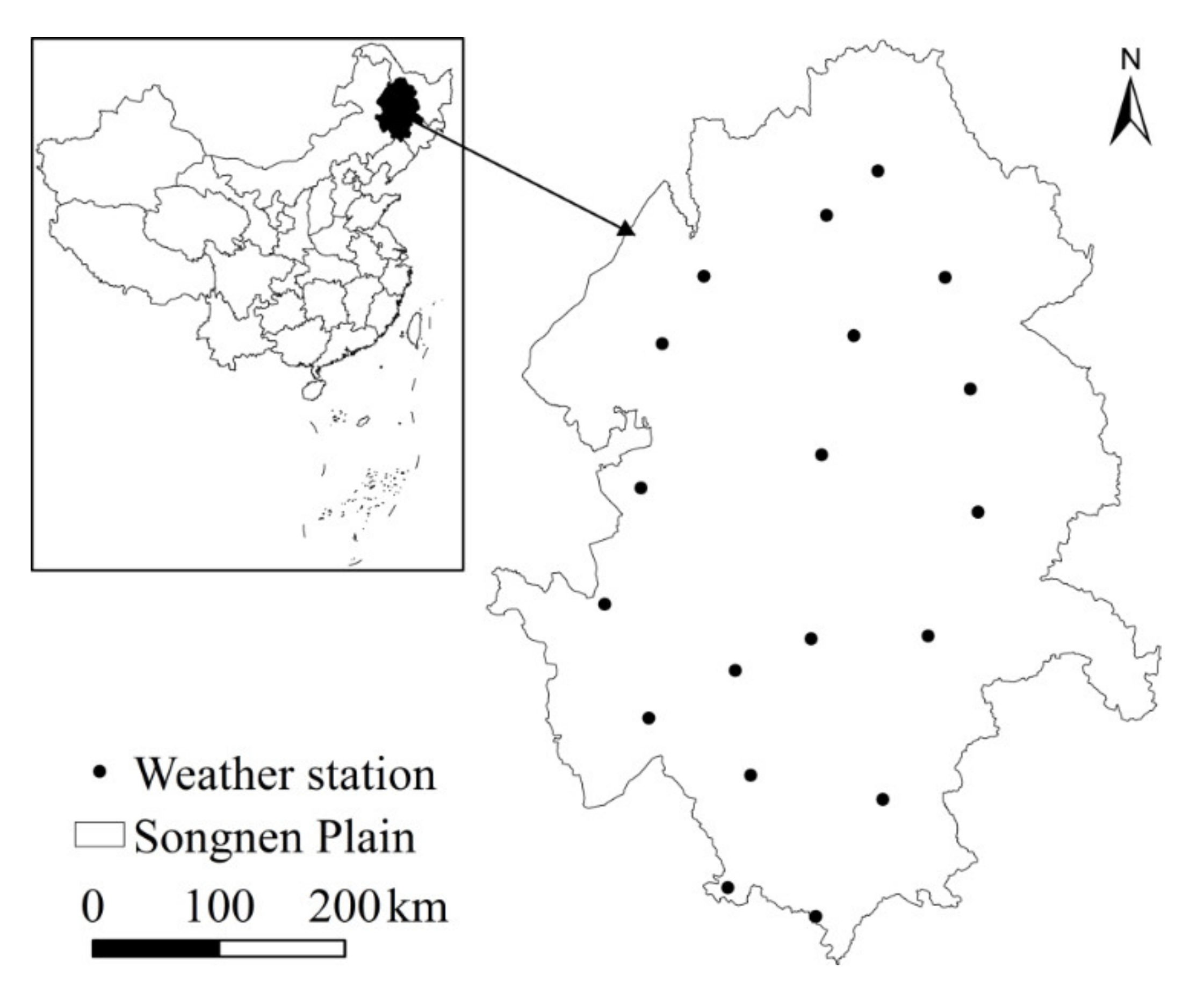
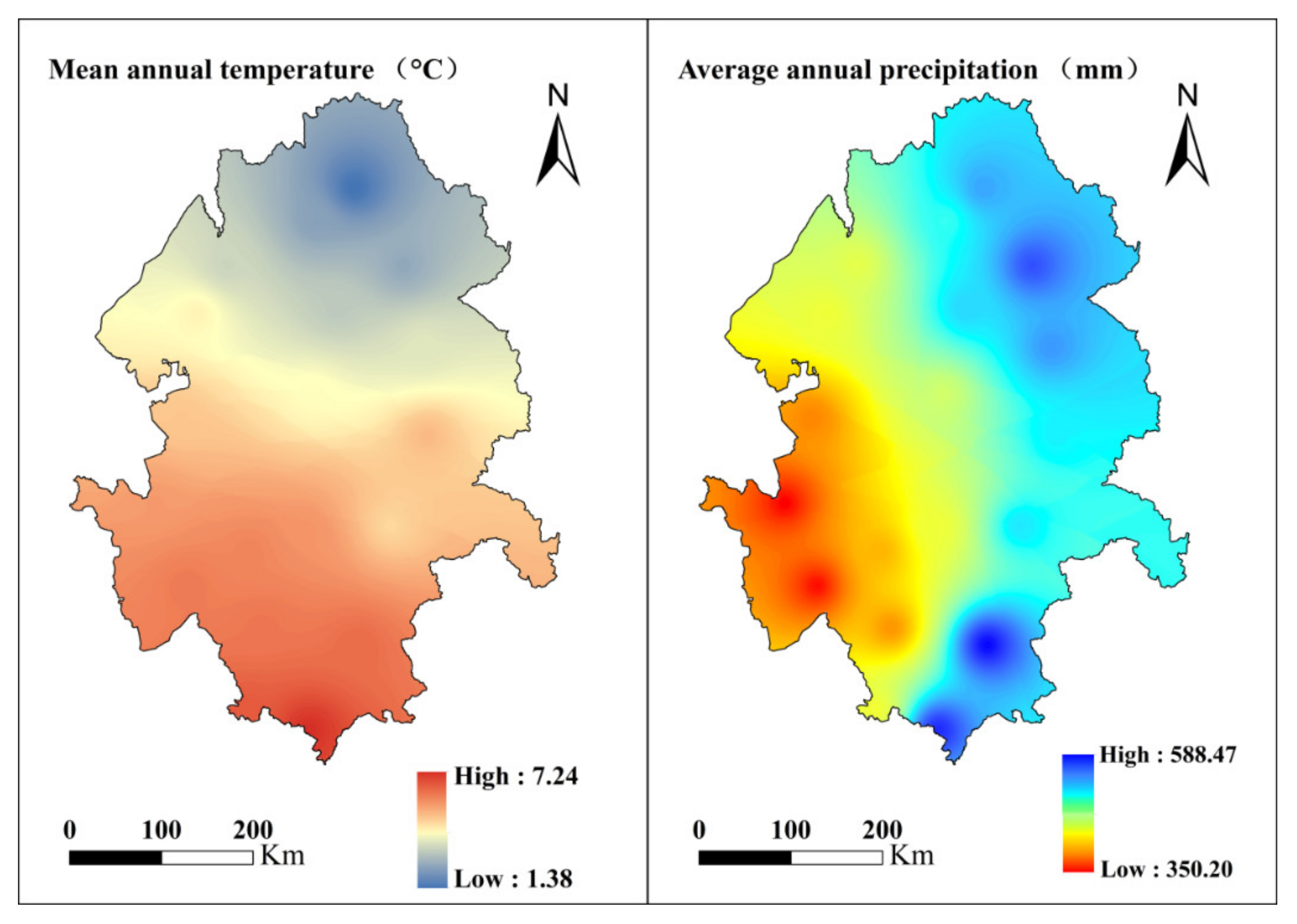



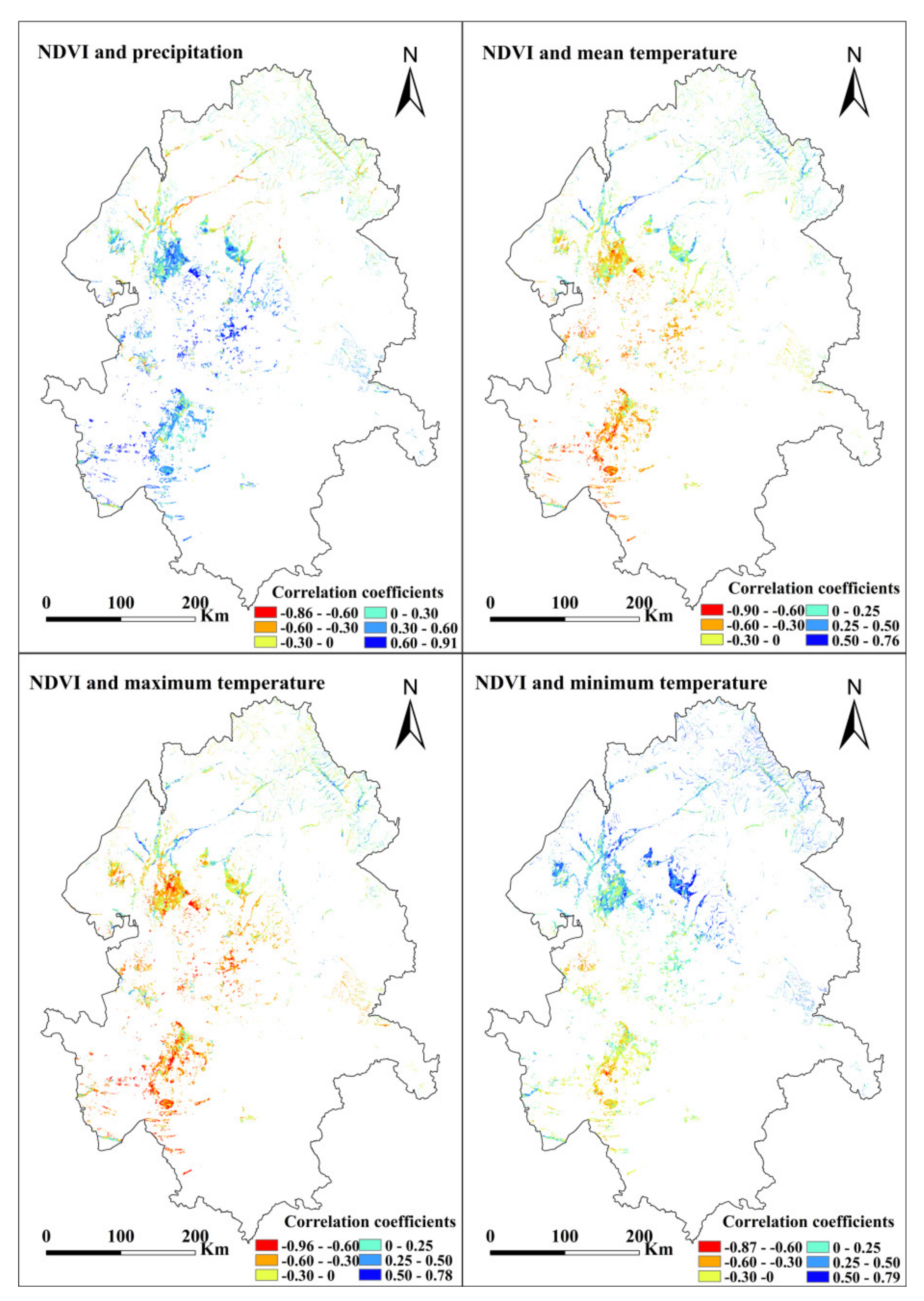
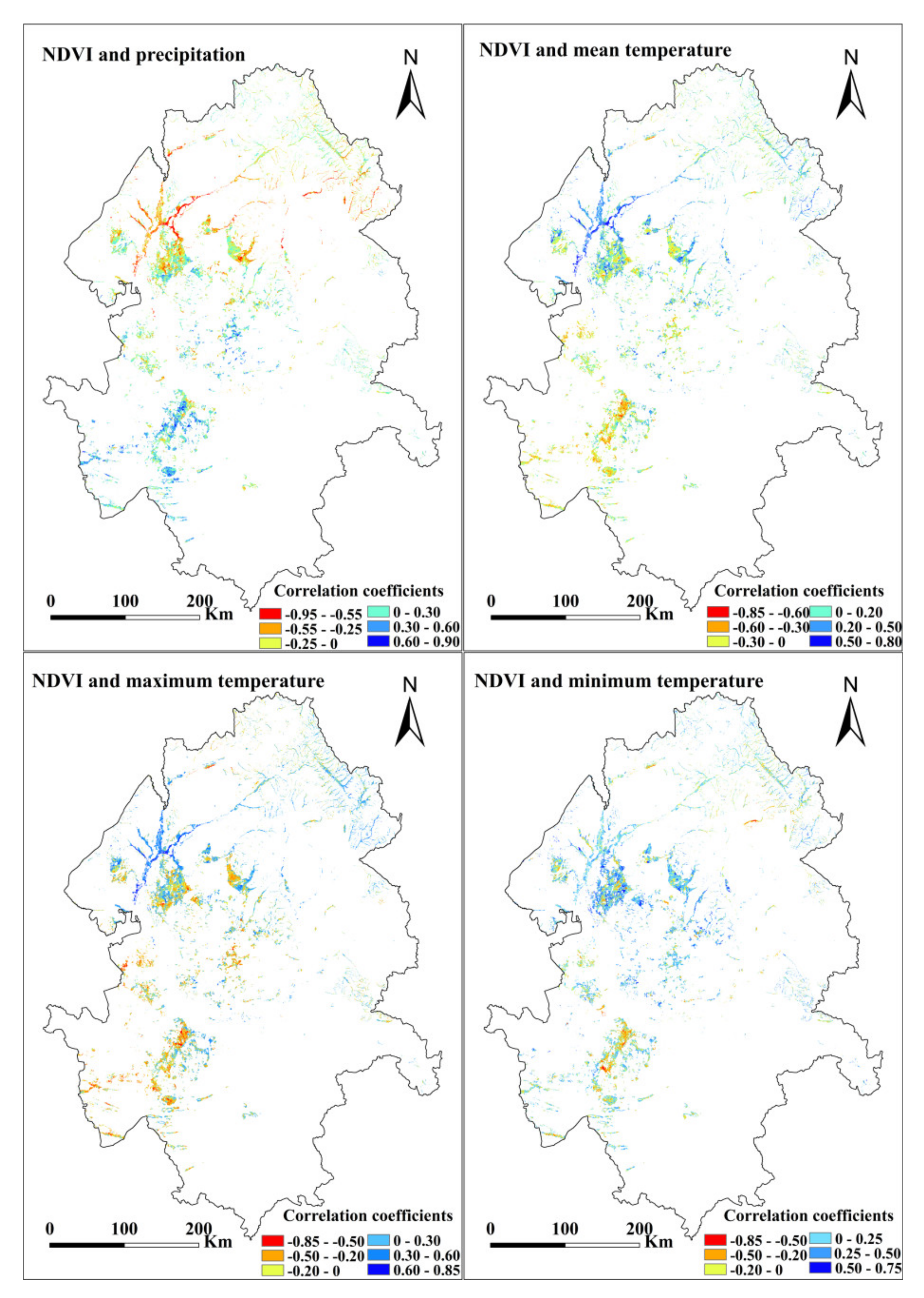


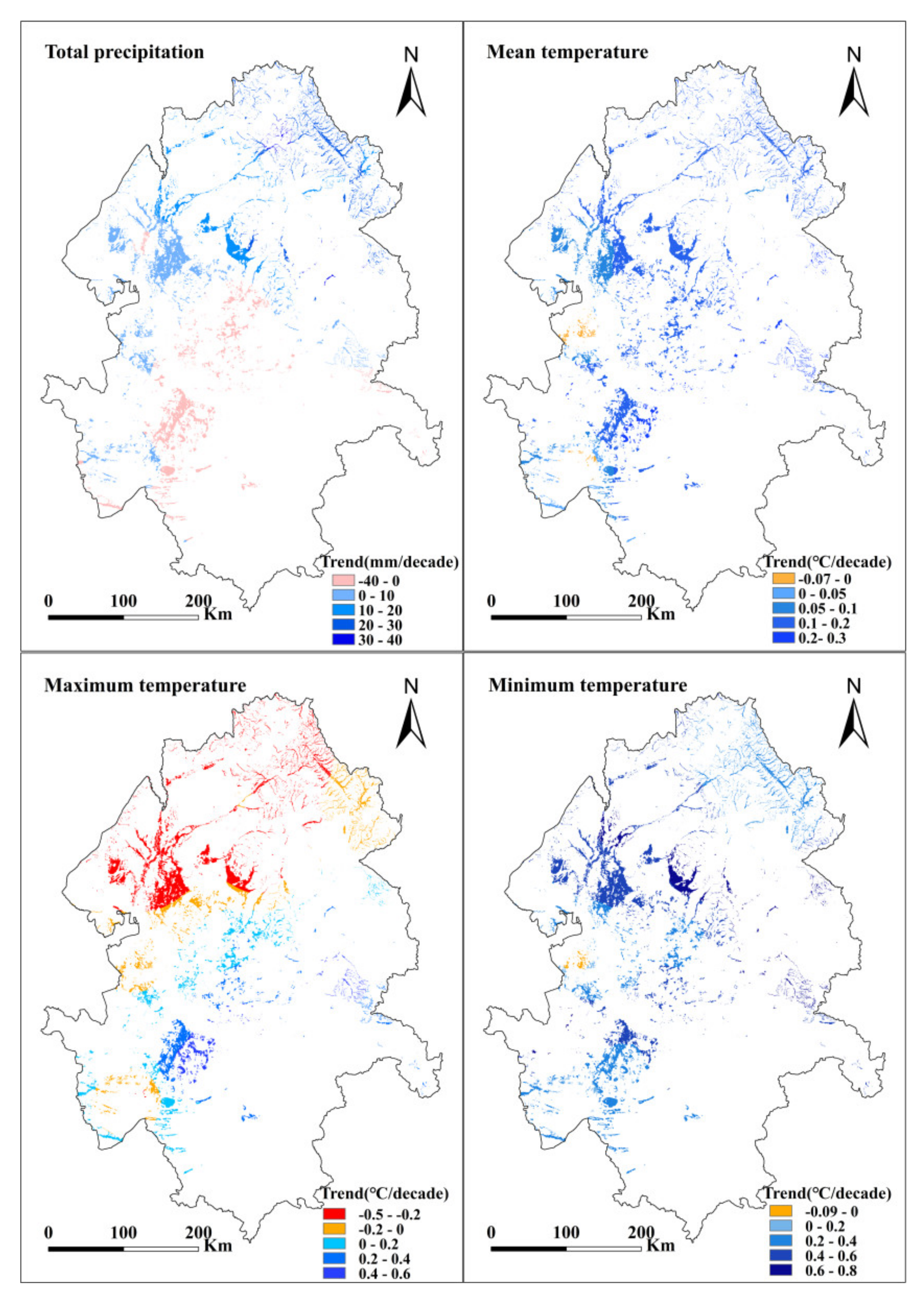
| Tmean | Tmax | Tmin | Precipitation | |
|---|---|---|---|---|
| Growing Season | −0.266 | −0.409 | 0.260 | 0.559 * |
| May | −0.234 | −0.332 | 0.239 | 0.735 ** |
| June | −0.123 | −0.228 | 0.180 | 0.339 |
| July | −0.165 | −0.312 | 0.217 | 0.252 |
| August | 0.211 | 0.165 | 0.339 | −0.171 |
| September | −0.174 | −0.351 | 0.148 | 0.417 |
| Tmean | Tmax | Tmin | Precipitation | |
|---|---|---|---|---|
| May | −0.05 | −0.10 * | 0.02 | 3.77 ** |
| June | −0.05 | −0.10 * | 0.03 | 2.96 * |
| July | −0.01 | −0.03 | 0.003 | 0.81 |
| August | 0.01 | 0.03 | 0.04 | 0.83 |
| September | −0.61 | −0.09 * | −0.01 | 3.25 * |
© 2020 by the authors. Licensee MDPI, Basel, Switzerland. This article is an open access article distributed under the terms and conditions of the Creative Commons Attribution (CC BY) license (http://creativecommons.org/licenses/by/4.0/).
Share and Cite
Wang, Y.; Shen, X.; Jiang, M.; Lu, X. Vegetation Change and Its Response to Climate Change between 2000 and 2016 in Marshes of the Songnen Plain, Northeast China. Sustainability 2020, 12, 3569. https://doi.org/10.3390/su12093569
Wang Y, Shen X, Jiang M, Lu X. Vegetation Change and Its Response to Climate Change between 2000 and 2016 in Marshes of the Songnen Plain, Northeast China. Sustainability. 2020; 12(9):3569. https://doi.org/10.3390/su12093569
Chicago/Turabian StyleWang, Yanji, Xiangjin Shen, Ming Jiang, and Xianguo Lu. 2020. "Vegetation Change and Its Response to Climate Change between 2000 and 2016 in Marshes of the Songnen Plain, Northeast China" Sustainability 12, no. 9: 3569. https://doi.org/10.3390/su12093569
APA StyleWang, Y., Shen, X., Jiang, M., & Lu, X. (2020). Vegetation Change and Its Response to Climate Change between 2000 and 2016 in Marshes of the Songnen Plain, Northeast China. Sustainability, 12(9), 3569. https://doi.org/10.3390/su12093569





